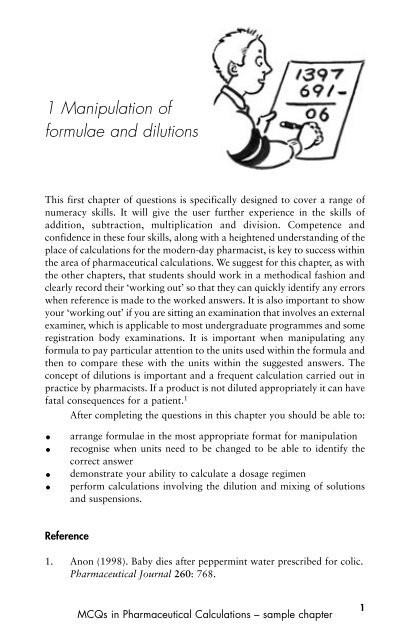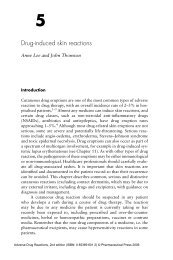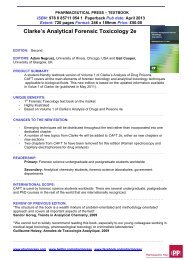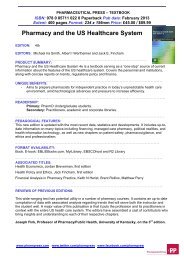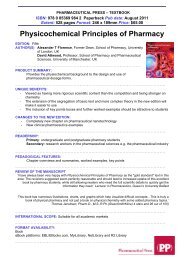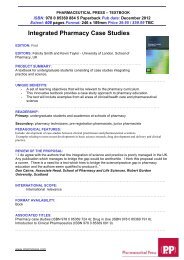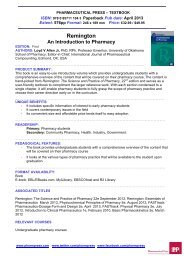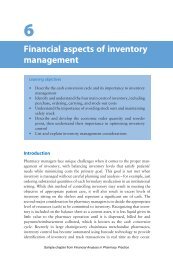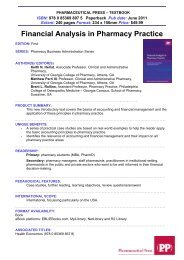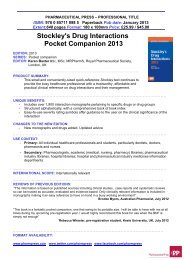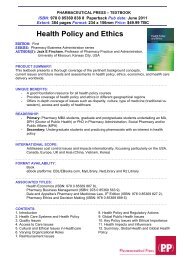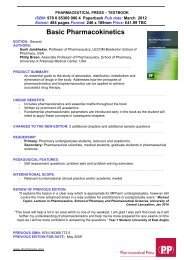1 Manipulation of formulae and dilutions - Pharmaceutical Press
1 Manipulation of formulae and dilutions - Pharmaceutical Press
1 Manipulation of formulae and dilutions - Pharmaceutical Press
Create successful ePaper yourself
Turn your PDF publications into a flip-book with our unique Google optimized e-Paper software.
1 <strong>Manipulation</strong> <strong>of</strong><br />
<strong>formulae</strong> <strong>and</strong> <strong>dilutions</strong><br />
This first chapter <strong>of</strong> questions is specifically designed to cover a range <strong>of</strong><br />
numeracy skills. It will give the user further experience in the skills <strong>of</strong><br />
addition, subtraction, multiplication <strong>and</strong> division. Competence <strong>and</strong><br />
confidence in these four skills, along with a heightened underst<strong>and</strong>ing <strong>of</strong> the<br />
place <strong>of</strong> calculations for the modern-day pharmacist, is key to success within<br />
the area <strong>of</strong> pharmaceutical calculations. We suggest for this chapter, as with<br />
the other chapters, that students should work in a methodical fashion <strong>and</strong><br />
clearly record their ‘working out’ so that they can quickly identify any errors<br />
when reference is made to the worked answers. It is also important to show<br />
your ‘working out’ if you are sitting an examination that involves an external<br />
examiner, which is applicable to most undergraduate programmes <strong>and</strong> some<br />
registration body examinations. It is important when manipulating any<br />
formula to pay particular attention to the units used within the formula <strong>and</strong><br />
then to compare these with the units within the suggested answers. The<br />
concept <strong>of</strong> <strong>dilutions</strong> is important <strong>and</strong> a frequent calculation carried out in<br />
practice by pharmacists. If a product is not diluted appropriately it can have<br />
fatal consequences for a patient. 1<br />
After completing the questions in this chapter you should be able to:<br />
•<br />
•<br />
•<br />
•<br />
arrange <strong>formulae</strong> in the most appropriate format for manipulation<br />
recognise when units need to be changed to be able to identify the<br />
correct answer<br />
demonstrate your ability to calculate a dosage regimen<br />
perform calculations involving the dilution <strong>and</strong> mixing <strong>of</strong> solutions<br />
<strong>and</strong> suspensions.<br />
Reference<br />
1. Anon (1998). Baby dies after peppermint water prescribed for colic.<br />
<strong>Pharmaceutical</strong> Journal 260: 768.<br />
MCQs in <strong>Pharmaceutical</strong> Calculations – sample chapter<br />
1
2 MCQs in <strong>Pharmaceutical</strong> Calculations<br />
QUESTIONS<br />
Directions for Questions 1–7. In this section, each question or incomplete<br />
statement is followed by five suggested answers. Select the best answer<br />
in each case.<br />
1 A liquid medicine is supplied in a concentration <strong>of</strong> 20 mg/5 mL. A<br />
patient requires 40 mg orally three times daily for 5 days, then 20 mg<br />
three times daily for 5 days, then 20 mg twice daily for 5 days <strong>and</strong> then<br />
20 mg once daily for 5 days. Which <strong>of</strong> the following is the volume <strong>of</strong><br />
liquid medicine that you will need to dispense?<br />
A 600 mL<br />
B 200 mL<br />
C 300 mL<br />
D 60 mL<br />
E 30 mL<br />
2 You are required to make 350 g <strong>of</strong> a paste that contains 15% w/w zinc<br />
oxide. Which <strong>of</strong> the following is the amount <strong>of</strong> zinc oxide required?<br />
A 5.25 g<br />
B 52.50 g<br />
C 35.00 g<br />
D 3.50 g<br />
E 15.00 g<br />
3 A 1 in 10 000 solution <strong>of</strong> potassium permanganate contains which <strong>of</strong><br />
the following concentrations?<br />
A 50.0 mg potassium permanganate in 500 mL solution<br />
B 1.0 mg potassium permanganate in 100 mL solution<br />
C 5.0 mg potassium permanganate in 500 mL solution<br />
D 1.0 mg potassium permanganate in 1000 mL solution<br />
E 3.0 mg potassium permanganate in 300 mL solution<br />
4 Which <strong>of</strong> the following volumes <strong>of</strong> an adrenaline 1 in 100 solution<br />
would be given by intramuscular injection to a 2-year-old child for<br />
treatment <strong>of</strong> anaphylaxis if the dose were 120 micrograms stat?<br />
A 12.00 mL<br />
B 120.00 mL<br />
MCQs in <strong>Pharmaceutical</strong> Calculations – sample chapter
C 0.12 mL<br />
D 24.0 mL<br />
E 0.24 mL<br />
<strong>Manipulation</strong> <strong>of</strong> <strong>formulae</strong> <strong>and</strong> <strong>dilutions</strong> 3<br />
5 Which <strong>of</strong> the following amounts <strong>of</strong> copper sulphate is required to make<br />
400 mL <strong>of</strong> an aqueous stock solution, such that, when the stock solution<br />
is diluted 50 times with water, a final solution <strong>of</strong> 0.1% w/v copper<br />
sulphate is produced?<br />
A 0.2 g<br />
B 20.0 g<br />
C 0.4 g<br />
D 40.0 g<br />
E 50.0 g<br />
6 A child requires a single oral daily dose <strong>of</strong> 7.0 mg/kg body weight <strong>of</strong><br />
drug A. The child’s weight is 8.0 kg. Which <strong>of</strong> the following oral daily<br />
doses <strong>of</strong> drug A is received by this child?<br />
A 0.82 mg<br />
B 8.20 mg<br />
C 82.00 mg<br />
D 5.60 mg<br />
E 56.00 mg<br />
7 A patient in one <strong>of</strong> the residential homes to which you supply<br />
medication is going on holiday <strong>and</strong> needs her prescriptions made up for<br />
the 5 days that she will be away. If she usually takes ranitidine 150 mg<br />
twice daily <strong>and</strong> atenolol 50 mg in the morning, which <strong>of</strong> the following<br />
combinations <strong>of</strong> Zantac syrup (75 mg ranitidine/5 mL) <strong>and</strong> Tenormin<br />
syrup (25 mg atenolol/5 mL) would you supply?<br />
A 50 mL Zantac syrup <strong>and</strong> 50 mL Tenormin syrup<br />
B 100 mL Zantac syrup <strong>and</strong> 50 mL Tenormin syrup<br />
C 50 mL Zantac syrup <strong>and</strong> 100 mL Tenormin syrup<br />
D 150 mL Zantac syrup <strong>and</strong> 50 mL Tenormin syrup<br />
E 75 mL Zantac syrup <strong>and</strong> 25 mL Tenormin syrup<br />
Directions for Questions 8–10. For each numbered question, select the one<br />
lettered option to which it is most closely related. Within the group <strong>of</strong><br />
questions, each lettered option may be used once, more than once or not<br />
at all.<br />
MCQs in <strong>Pharmaceutical</strong> Calculations – sample chapter
4 MCQs in <strong>Pharmaceutical</strong> Calculations<br />
Questions 8–10 concern the following quantities:<br />
A 100 mL<br />
B 1000 mL<br />
C 4200 mL<br />
D 420 mL<br />
E 4.2 mL<br />
Select, from A to E above, which is appropriate:<br />
8 The volume <strong>of</strong> an oral liquid medicine, available as 2 mg drug X/5 mL,<br />
which is required for a 14-day supply for a patient prescribed a dose<br />
<strong>of</strong> 4 mg drug X three times daily.<br />
9 The volume <strong>of</strong> alcohol 95% v/v needed to produce 1.90 L <strong>of</strong> 50% v/v.<br />
10 The volume <strong>of</strong> concentrated peppermint water required to make 16.8 L<br />
<strong>of</strong> single-strength peppermint water. (Single-strength peppermint water<br />
is 1 part concentrate to 39 parts water.)<br />
Directions for Questions 11 <strong>and</strong> 12. The questions in this section are<br />
followed by three responses. ONE or MORE <strong>of</strong> the responses is (are)<br />
correct. Decide which <strong>of</strong> the responses is (are) correct. Then choose:<br />
Directions summarised:<br />
A B C D E<br />
1, 2, 3 1, 2 only 2, 3 only 1 only 3 only<br />
11 Which <strong>of</strong> the following is/are correct?<br />
1 2.0 mL codeine adult linctus (15.0 mg/5.0 mL) is required to<br />
make up 100.0 mL paediatric codeine linctus (3.0 mg/5.0 mL)<br />
2 10.0 g calcium carbonate is needed to prepare 1.0 L solution<br />
such that 50.0 mL <strong>of</strong> this solution diluted to 200.0 mL gives<br />
a 0.5% w/v solution<br />
3 0.045% w/v is equivalent to 450 micrograms/mL<br />
MCQs in <strong>Pharmaceutical</strong> Calculations – sample chapter
12 Which <strong>of</strong> the following is/are correct?<br />
<strong>Manipulation</strong> <strong>of</strong> <strong>formulae</strong> <strong>and</strong> <strong>dilutions</strong> 5<br />
1 20.0 mg in 5.0 mL equates to a 1 in 250 solution<br />
2 3.2 g <strong>of</strong> 5-aminolevulinic acid hydrochloride is required to<br />
make 800.0 mL <strong>of</strong> a 0.4% w/v solution<br />
3 A 1 in 125 solution equates to 0.8% w/v<br />
Directions for Questions 13–19. In this section, each question or<br />
incomplete statement is followed by five suggested answers. Select the best<br />
answer in each case.<br />
13 Potassium permanganate solution 1 in 8000 is prepared from a stock<br />
<strong>of</strong> 10 times this strength. How much potassium permanganate will be<br />
needed to make sufficient stock solution if a patient uses 200 mL <strong>of</strong> the<br />
diluted solution each day for 20 days?<br />
A 100 mg<br />
B 125 mg<br />
C 250 mg<br />
D 400 mg<br />
E 500 mg<br />
14 What volume <strong>of</strong> phenytoin suspension 30 mg/5 mL is required to be<br />
added to a suitable diluent to obtain 150 mL phenytoin suspension<br />
20 mg/5 mL?<br />
A 75 mL<br />
B 100 mL<br />
C 120 mL<br />
D 125 mL<br />
E 130 mL<br />
15 Given a 20% w/v solution <strong>of</strong> chlorhexidine gluconate, what volume is<br />
required to make 400 mL <strong>of</strong> a 2% w/v solution?<br />
A 40 mL<br />
B 20 mL<br />
C 80 mL<br />
D 2mL<br />
E 4mL<br />
MCQs in <strong>Pharmaceutical</strong> Calculations – sample chapter
6 MCQs in <strong>Pharmaceutical</strong> Calculations<br />
16 Which <strong>of</strong> the following shows the correct amounts <strong>of</strong> sodium chloride<br />
<strong>and</strong> anhydrous glucose present in 500 mL <strong>of</strong> intravenous infusion<br />
containing sodium chloride 0.18% w/v <strong>and</strong> anhydrous glucose 4.00%<br />
w/v?<br />
A Sodium chloride 0.18 g <strong>and</strong> anhydrous glucose 20.00 g<br />
B Sodium chloride 0.90 g <strong>and</strong> anhydrous glucose 20.00 g<br />
C Sodium chloride 0.90 g <strong>and</strong> anhydrous glucose 40.00 g<br />
D Sodium chloride 1.80 g <strong>and</strong> anhydrous glucose 20.00 g<br />
E Sodium chloride 1.80 g <strong>and</strong> anhydrous glucose 40.00 g<br />
17 You are presented with a prescription for allopurinol tablets 100 mg at<br />
a dose <strong>of</strong> 300 mg each day for 14 days, reducing to 200 mg for a further<br />
7 days. How many packs <strong>of</strong> 28 tablets should you supply?<br />
A Two<br />
B Three<br />
C One<br />
D Four<br />
E One <strong>and</strong> a half<br />
18 An injection solution contains 0.5% w/v <strong>of</strong> active ingredient. How much<br />
<strong>of</strong> the active ingredient is needed to prepare 500 L <strong>of</strong> solution?<br />
A 0.25 kg<br />
B 0.50 kg<br />
C 1.00 kg<br />
D 2.50 kg<br />
E 5.00 kg<br />
19 A patient taking 10.0 mL Erythroped suspension (250 mg/5 mL) qid<br />
will receive how much erythromycin each day?<br />
A 2.0 g<br />
B 20.0 g<br />
C 4.0 g<br />
D 40.0 g<br />
E 2.5 g<br />
Directions for Questions 20–22. For each numbered question, select the<br />
one lettered option that is most closely related to it. Within the group <strong>of</strong><br />
questions, each lettered option may be used once, more than once or not<br />
at all.<br />
MCQs in <strong>Pharmaceutical</strong> Calculations – sample chapter
<strong>Manipulation</strong> <strong>of</strong> <strong>formulae</strong> <strong>and</strong> <strong>dilutions</strong> 7<br />
Questions 20–22 concern the following numbers:<br />
A 10<br />
B 15<br />
C 20<br />
D 60<br />
E 25<br />
Select, from A to E above, which is appropriate:<br />
20 The number <strong>of</strong> days a 150 mL bottle <strong>of</strong> nitrazepam 2.5 mg/5 mL<br />
suspension will last a patient prescribed nitrazepam 5 mg at bedtime<br />
for insomnia.<br />
21 The number <strong>of</strong> tablets required to fulfil the following prescription:<br />
Prednisolone 5 mg e/c tablets<br />
Take 25 mg daily for 4 days, then reduce by 5 mg every 4 days until<br />
the course is finished (total course: 20 days)<br />
22 The number <strong>of</strong> drops per minute required if 720 mL <strong>of</strong> 5% w/v glucose<br />
is to be given intravenously to a patient over a 12-hour period. It is<br />
known that 20 drops = 1 mL.<br />
Directions for Questions 23 <strong>and</strong> 24. The questions in this section are<br />
followed by three responses. ONE or MORE <strong>of</strong> the responses is (are)<br />
correct. Decide which <strong>of</strong> the responses is (are) correct. Then choose:<br />
Directions summarised:<br />
A B C D E<br />
1, 2, 3 1, 2 only 2, 3 only 1 only 3 only<br />
23 Which <strong>of</strong> the following is/are correct?<br />
1 In order to make 250 g <strong>of</strong> 0.5% w/w salicylic acid in Hydrous<br />
Ointment, BP, 1.25 g salicylic acid is required<br />
2 400 mL <strong>of</strong> a 1 in 2000 solution <strong>of</strong> pr<strong>of</strong>lavine hemisulphate<br />
contains 0.02 g <strong>of</strong> the drug<br />
MCQs in <strong>Pharmaceutical</strong> Calculations – sample chapter
8 MCQs in <strong>Pharmaceutical</strong> Calculations<br />
3 4 × 100 mg spironolactone tablets will be required to make<br />
100 mL <strong>of</strong> a 25 mg/5 mL spironolactone suspension for a<br />
patient who is unable to swallow solids<br />
24 Which <strong>of</strong> the following is/are correct?<br />
1 A patient weighing 12.5 kg requires an oral daily dose <strong>of</strong><br />
trimethoprim 2 mg/kg for 10 days. You would need to supply<br />
25 mL trimethoprim suspension 50 mg/5 mL<br />
2 560 mL cimetidine suspension 200 mg/5 mL is required to be<br />
sent to a nursing home resident to cover a 28-day supply if the<br />
resident takes 400 mg twice daily<br />
3 A patient requires four tablets a day for 56 days; you would<br />
supply 224 tablets<br />
Directions for Questions 25–31. In this section, each question or<br />
incomplete statement is followed by five suggested answers. Select the best<br />
answer in each case.<br />
25 In your pharmacy you have a stock solution <strong>of</strong> drug F with a<br />
concentration <strong>of</strong> 25% w/v. Drug F is used as a mouthwash at a concentration<br />
<strong>of</strong> 0.25% w/v. You are requested to supply 50 mL <strong>of</strong> a solution<br />
<strong>of</strong> intermediate strength, such that the patient will dilute this solution 1<br />
in 20 to get the correct concentration immediately before use. Which <strong>of</strong><br />
the following should be the concentration <strong>of</strong> the intermediate solution?<br />
A 5% w/v<br />
B 10% w/v<br />
C 2.5% w/v<br />
D 0.5% w/v<br />
E 15% w/v<br />
26 You receive a prescription for phenindione tablets 50 mg with the<br />
following instructions: ‘200 mg on day 1, 100 mg on day 2 <strong>and</strong> then<br />
50 mg daily thereafter’. Mitte: 56 days’ supply.<br />
Which <strong>of</strong> the following is the correct quantity to supply?<br />
A 60 tablets<br />
B 84 tablets<br />
C 56 tablets<br />
D 120 tablets<br />
E 90 tablets<br />
MCQs in <strong>Pharmaceutical</strong> Calculations – sample chapter
<strong>Manipulation</strong> <strong>of</strong> <strong>formulae</strong> <strong>and</strong> <strong>dilutions</strong> 9<br />
27 An ointment contains 1% w/w calamine. Which <strong>of</strong> the following is the<br />
amount <strong>of</strong> calamine powder that should be added to 200 g <strong>of</strong> the<br />
ointment to produce a 4% w/w calamine ointment?<br />
A 0.625 g<br />
B 6.250 g<br />
C 62.50 g<br />
D 5.0 g<br />
E 50.0 g<br />
28 A patient weighing 30 kg requires a single oral daily dose <strong>of</strong> 9 mg/kg<br />
<strong>of</strong> drug B. This drug is available only as a suspension <strong>of</strong> 15 mg/5 mL.<br />
How much suspension would you supply?<br />
A 1350 mL<br />
B 45 mL<br />
C 50 mL<br />
D 100 mL<br />
E 90 mL<br />
29 Which <strong>of</strong> the following is the volume <strong>of</strong> a 6% w/v solution that is<br />
required to give a single dose <strong>of</strong> 12 mg?<br />
A 4.0 mL<br />
B 2.0 mL<br />
C 0.2 mL<br />
D 0.5 mL<br />
E 1.0 mL<br />
30 Fertiliser residues are sometimes found in drinking water in rural areas.<br />
For compound Z, the safe limit for drinking water is 9 ppm. Analytical<br />
results for the amount <strong>of</strong> compound Z in the drinking water <strong>of</strong> various<br />
villages are given below. Which ONE <strong>of</strong> the following villages has<br />
drinking water that is safe to drink?<br />
A Toome: 24.6 micrograms/mL<br />
B Blackhill: 0.3 mg/L<br />
C Drumhowan: 0.009% w/v<br />
D Magheracloone: 0.041% w/v<br />
E Annagassan: 1 in 100 000<br />
31 Which <strong>of</strong> the following is the concentration <strong>of</strong> a solution prepared by<br />
dissolving 400 mg potassium permanganate in water <strong>and</strong> making up to<br />
a final volume <strong>of</strong> 4.0 L.<br />
MCQs in <strong>Pharmaceutical</strong> Calculations – sample chapter
10 MCQs in <strong>Pharmaceutical</strong> Calculations<br />
A 4% w/v<br />
B 1% w/v<br />
C 0.4% w/v<br />
D 0.1% w/v<br />
E 0.01% w/v<br />
Directions for Questions 32–34. For each numbered question, select the<br />
one lettered option that is most closely related to it. Within the group <strong>of</strong><br />
questions, each lettered option may be used once, more than once or not<br />
at all.<br />
Questions 32, 33 <strong>and</strong> 34 concern the following quantities:<br />
A 0.8 mL<br />
B 8.0 mL<br />
C 150.0 mL<br />
D 0.15 mL<br />
E 1.5 mL<br />
Select, from A to E above, which is appropriate:<br />
32 The volume <strong>of</strong> amoxicillin syrup 125 mg/5 mL required by a child<br />
prescribed 250 mg amoxicillin orally three times daily for 5 days.<br />
33 The volume <strong>of</strong> a 5% w/v solution required to give a dose <strong>of</strong> 40 mg.<br />
34 The volume required to give a 15 mg dose <strong>of</strong> haloperidol from a 2 mL<br />
ampoule containing 10 mg haloperidol/mL.<br />
Directions for Questions 35 <strong>and</strong> 36. The questions in this section are<br />
followed by three responses. ONE or MORE <strong>of</strong> the responses is (are)<br />
correct. Decide which <strong>of</strong> the responses is (are) correct. Then choose:<br />
Directions summarised:<br />
A B C D E<br />
1, 2, 3 1, 2 only 2, 3 only 1 only 3 only<br />
35 Which <strong>of</strong> the following is/are correct?<br />
1 40 mL <strong>of</strong> a 5% v/v ethanol solution contains 0.2 mL ethanol<br />
MCQs in <strong>Pharmaceutical</strong> Calculations – sample chapter
2 1000 mL <strong>of</strong> a 3% w/v salicylic acid lotion contains 30 g<br />
salicylic acid<br />
3 200 mL <strong>of</strong> a 0.02%w/v beclometasone solution contains 0.04 g<br />
beclometasone<br />
36 Which <strong>of</strong> the following is/are correct?<br />
<strong>Manipulation</strong> <strong>of</strong> <strong>formulae</strong> <strong>and</strong> <strong>dilutions</strong> 11<br />
1 Peptac suspension contains 3.1 mmol sodium/5 mL. A patient<br />
taking Peptac suspension 20 mL three times daily receives<br />
37.2 mmol sodium ions from this medication each day<br />
2 A suitable dose <strong>of</strong> carbamazepine in epilepsy for a child up to<br />
1 year is 100–200 mg daily in divided doses. An appropriate<br />
dose <strong>of</strong> Tegretol liquid (100 mg carbamazepine/5 mL) for a<br />
10-month-old baby with epilepsy is 7.5 mL daily in divided<br />
doses<br />
3 A doctor requests 50.00 g <strong>of</strong> 0.05% w/w salicylic acid cream.<br />
The amount <strong>of</strong> salicylic acid required to prepare this cream is<br />
2.50 mg<br />
Directions for Questions 37–43. In this section, each question or<br />
incomplete statement is followed by five suggested answers. Select the best<br />
answer in each case.<br />
37 You mix together 50 g <strong>of</strong> 0.5% w/w hydrocortisone cream <strong>and</strong> 25 g <strong>of</strong><br />
2% w/w sulphur cream (the creams are compatible). What is the final<br />
concentration <strong>of</strong> each <strong>of</strong> the two drugs?<br />
A 0.5% w/w hydrocortisone cream <strong>and</strong> 2.0% w/w sulphur<br />
B 0.25% w/w hydrocortisone cream <strong>and</strong> 1.00% w/w sulphur<br />
C 0.33% w/w hydrocortisone cream <strong>and</strong> 0.67% w/w sulphur<br />
D 0.67% w/w hydrocortisone cream <strong>and</strong> 0.33% w/w sulphur<br />
E 0.33% w/w hydrocortisone cream <strong>and</strong> 0.33% w/w sulphur<br />
38 A patient is prescribed a reducing oral dose <strong>of</strong> prednisolone as follows:<br />
Day 1: 10 mg<br />
Day 2: 8 mg<br />
Day 3: 6 mg<br />
Day 4: 4 mg<br />
Day 5: 3 mg<br />
MCQs in <strong>Pharmaceutical</strong> Calculations – sample chapter
12 MCQs in <strong>Pharmaceutical</strong> Calculations<br />
Day 6: 2 mg<br />
Day 7: 1 mg<br />
Prednisolone is supplied as 5 mg <strong>and</strong> 1 mg tablets. Prednisolone tablets<br />
cannot be split. Therefore, the patient needs to take a number <strong>of</strong> whole<br />
tablets. How many <strong>of</strong> each tablet strength would it be most appropriate to<br />
supply?<br />
A Four 5 mg tablets <strong>and</strong> fourteen 1 mg tablets<br />
B Fourteen 5 mg tablets <strong>and</strong> four 1 mg tablets<br />
C Five 5 mg tablets <strong>and</strong> fifteen 1 mg tablets<br />
D Fifteen 5 mg tablets <strong>and</strong> five 1 mg tablets<br />
E One 5 mg tablet <strong>and</strong> twenty 1 mg tablets<br />
39 A patient weighing 50 kg requires a single oral daily dose <strong>of</strong> 9 mg/kg<br />
<strong>of</strong> drug Y. This drug is available only as a suspension <strong>of</strong> 150 mg/5 mL.<br />
How much suspension would it be most appropriate to supply to<br />
provide a single dose?<br />
A 10 mL<br />
B 5mL<br />
C 20 mL<br />
D 15 mL<br />
E 25 mL<br />
40 You are requested to supply 35 g <strong>of</strong> a cream containing 20% w/w<br />
methylaminolevulinate for use in a photodynamic therapy clinical trial.<br />
You have Cetomacrogol Cream, BP in your hospital pharmacy<br />
department <strong>and</strong> can use this as the cream base. What is the formula for<br />
your methylaminolevulinate cream?<br />
A 10 g methylaminolevulinate <strong>and</strong> 25 g Cetomacrogol Cream,<br />
BP<br />
B 30 g methylaminolevulinate <strong>and</strong> 5 g Cetomacrogol Cream, BP<br />
C 5 g methylaminolevulinate <strong>and</strong> 30 g Cetomacrogol Cream, BP<br />
D 7 g methylaminolevulinate <strong>and</strong> 28 g Cetomacrogol Cream, BP<br />
E 28 g methylaminolevulinate <strong>and</strong> 7 g Cetomacrogol Cream, BP<br />
41 You have in your pharmacy a cream containing 0.5% w/w<br />
hydrocortisone. You have been requested to use this cream as a base<br />
<strong>and</strong> to add in sufficient calamine such that the final concentration <strong>of</strong><br />
calamine in the new cream will be 10.0% w/w. What is the<br />
concentration <strong>of</strong> hydrocortisone in the new cream?<br />
MCQs in <strong>Pharmaceutical</strong> Calculations – sample chapter
A 0.3% w/w<br />
B 0.45% w/w<br />
C 0.5% w/w<br />
D 0.05% w/w<br />
E 0.045% w/w<br />
<strong>Manipulation</strong> <strong>of</strong> <strong>formulae</strong> <strong>and</strong> <strong>dilutions</strong> 13<br />
42 A stock solution <strong>of</strong> drug G is available at 10%w/v. You need to dilute<br />
this with Syrup, BP in order to supply a patient with a solution<br />
containing 5 mg/mL <strong>of</strong> drug G. Assuming no volume displacement<br />
effects, what is your formula for the preparation <strong>of</strong> 100 mL <strong>of</strong> the final<br />
solution?<br />
A 10 mL stock solution <strong>and</strong> 90 mL Syrup, BP<br />
B 80 mL stock solution <strong>and</strong> 20 mL Syrup, BP<br />
C 20 mL stock solution <strong>and</strong> 80 mL Syrup, BP<br />
D 95 mL stock solution <strong>and</strong> 5 mL Syrup, BP<br />
E 5 mL stock solution <strong>and</strong> 95 mL Syrup, BP<br />
43 A patient is on a continuous intravenous drip <strong>of</strong> drug B. He needs to<br />
be dosed at a rate <strong>of</strong> 25 mg/h. The drip is set to administer 10 drops<br />
<strong>of</strong> fluid/h, with 4 drops equalling 1 mL in volume. Which <strong>of</strong> the<br />
following is the concentration <strong>of</strong> drug B in the intravenous fluid?<br />
A 1 mg/mL<br />
B 10 mg/mL<br />
C 5 mg/mL<br />
D 2.5 mg/mL<br />
E 25 mg/mL<br />
Directions for Questions 44–46. For each numbered question, select the<br />
one lettered option that is most closely related to it. Within the group <strong>of</strong><br />
questions, each lettered option may be used once, more than once or not<br />
at all.<br />
Questions 44, 45 <strong>and</strong> 46 concern the following quantities:<br />
A 0.02 mg<br />
B 0.20 mg<br />
C 2.00 mg<br />
D 1.00 mg<br />
E 0.10 mg<br />
Select, from A to E above, which is appropriate:<br />
MCQs in <strong>Pharmaceutical</strong> Calculations – sample chapter
14 MCQs in <strong>Pharmaceutical</strong> Calculations<br />
44 The amount <strong>of</strong> phytomenadione contained in a 0.2 mL ampoule <strong>of</strong><br />
10 mg/mL solution.<br />
45 The weight <strong>of</strong> chlorhexidine contained in 2 mL <strong>of</strong> a 1 in 10 000<br />
solution.<br />
46 The weight <strong>of</strong> ethambutol contained in 0.4 mL <strong>of</strong> 250 micrograms/mL<br />
solution.<br />
Directions for Questions 47 <strong>and</strong> 48. The questions in this section are<br />
followed by three responses. ONE or MORE <strong>of</strong> the responses is (are)<br />
correct. Decide which <strong>of</strong> the responses is (are) correct. Then choose:<br />
Directions summarised:<br />
A B C D E<br />
1, 2, 3 1, 2 only 2, 3 only 1 only 3 only<br />
47 Which <strong>of</strong> the following is/are correct?<br />
1 125 g porfimer sodium is needed to produce 200 mL <strong>of</strong> a stock<br />
solution which, when 10 mL is diluted to 5 L, produces a 1 in<br />
8000 solution<br />
2 0.02 mL <strong>of</strong> a 1 in 10 000 solution will provide a 0.2 mg dose<br />
<strong>of</strong> dexamethasone<br />
3 A patient is prescribed three tablets a day for 56 days; you<br />
should supply 168 tablets<br />
48 Drug D is given in total daily doses based on body surface area, with<br />
the st<strong>and</strong>ard total daily dose being 2.2 mg/m2 . Which <strong>of</strong> the following<br />
is/are correct?<br />
1 A patient with body surface area <strong>of</strong> 1.80 m2 should receive a<br />
total daily dose <strong>of</strong> 3.96 mg<br />
2 A patient with body surface area <strong>of</strong> 2.00 m2 should receive a<br />
total daily dose <strong>of</strong> 4.40 mg<br />
3 A patient with body surface area <strong>of</strong> 1.50 m2 should receive a<br />
total daily dose <strong>of</strong> 3.30 mg<br />
MCQs in <strong>Pharmaceutical</strong> Calculations – sample chapter
<strong>Manipulation</strong> <strong>of</strong> <strong>formulae</strong> <strong>and</strong> <strong>dilutions</strong> 15<br />
Directions for Questions 49–55. In this section, each question or<br />
incomplete statement is followed by five suggested answers. Select the best<br />
answer in each case.<br />
49 You are providing prescribing advice to a local surgery. To assist in<br />
prescribing inhaled salbutamol cost-effectively you need to compare the<br />
cost <strong>of</strong> the preparations listed. Which one <strong>of</strong> the following is the least<br />
expensive for a 200 micrograms dose?<br />
A Accuhaler 60 doses/200 micrograms per dose (£6.00/<br />
US$11.70)<br />
B Generic inhaler 200 doses/100 micrograms per dose (£2.00/<br />
US$3.90)<br />
C Easi-Breathe inhaler 200 doses/100 micrograms per dose<br />
(£6.00/US$11.70)<br />
D Rotacaps 200 micrograms × 112 doses (£5.60/US$10.92)<br />
E Salbutodiscs 200 micrograms/14 × 8 dose refill (£5.60/<br />
US$10.92)<br />
50 It is recommended that fluoride supplements be taken when the<br />
municipal water supply has a fluoride content <strong>of</strong> > 700 micrograms/L.<br />
Test results on fluoride content <strong>of</strong> drinking water from various towns<br />
are listed below. People from which ONE <strong>of</strong> these towns should take<br />
fluoride supplements?<br />
A Tyholl<strong>and</strong>: 0.8 ppm<br />
B Cremartin: 0.6 micrograms/mL<br />
C Doohamlet: 0.00013% w/v<br />
D Carrickmacross: 0.00041% w/v<br />
E Annadrummond: 1 in 100 000<br />
51 A liquid medicine is supplied in a concentration <strong>of</strong> 10 mg/5 mL. A patient<br />
requires 20 mg orally three times daily for 5 days, then 10 mg three times<br />
daily for 5 days, then 10 mg twice daily for 5 days, then 10 mg once<br />
daily for 5 days. Which <strong>of</strong> the following is the correct volume <strong>of</strong> the<br />
liquid medicine that will provide the full treatment course?<br />
A 300 mL<br />
B 200 mL<br />
C 100 mL<br />
D 150 mL<br />
E 250 mL<br />
MCQs in <strong>Pharmaceutical</strong> Calculations – sample chapter
16 MCQs in <strong>Pharmaceutical</strong> Calculations<br />
52 A patient requires an intravenous infusion <strong>of</strong> 0.9%w/v sodium chloride.<br />
In your hospital pharmacy department you have Water for Injections,<br />
BP <strong>and</strong> 4.5%w/v Sodium Chloride Solution, BP. Assuming no volume<br />
displacement effects, which <strong>of</strong> the following volumes <strong>of</strong> 4.5% w/v<br />
Sodium Chloride Solution, BP need to be added aseptically to an<br />
exp<strong>and</strong>able PVC infusion bag containing 100 mL Water for Injections,<br />
BP to produce the requisite sodium chloride concentration?<br />
A 25 mL<br />
B 50 mL<br />
C 100 mL<br />
D 125 mL<br />
E 150 mL<br />
53 A patient needs to use a 1 in 2500 chlorhexidine gluconate solution<br />
for wound washing. In your pharmacy you have a stock solution<br />
<strong>of</strong> 20%w/v chlorhexidine gluconate. Using this solution you need<br />
to prepare an intermediate solution such that the patient will then<br />
dilute this 20-fold to obtain a solution <strong>of</strong> the requisite concentration.<br />
Which <strong>of</strong> the following is the correct strength <strong>of</strong> the intermediate<br />
solution?<br />
A 0.5% w/w<br />
B 0.2% w/w<br />
C 1.0% w/w<br />
D 0.4% w/w<br />
E 0.8% w/w<br />
54 Which <strong>of</strong> the following is the correct volume <strong>of</strong> a 5% w/v solution<br />
required to supply 150 mg <strong>of</strong> the active ingredient?<br />
A 30 mL<br />
B 20 mL<br />
C 3mL<br />
D 2mL<br />
E 5mL<br />
55 According to an <strong>of</strong>ficial formula for potassium citrate mixture, 300 mL<br />
double-strength chlor<strong>of</strong>orm water is required per 1 L mixture. A 2-L<br />
bottle <strong>of</strong> mixture is required. If the double-strength chlor<strong>of</strong>orm water<br />
is prepared from concentrated chlor<strong>of</strong>orm water, which <strong>of</strong> the<br />
following is the correct volume <strong>of</strong> concentrate required? (Doublestrength<br />
chlor<strong>of</strong>orm water is 2 parts concentrate to 38 parts water.)<br />
MCQs in <strong>Pharmaceutical</strong> Calculations – sample chapter
A 10 mL<br />
B 20 mL<br />
C 3mL<br />
D 30 mL<br />
E 15 mL<br />
<strong>Manipulation</strong> <strong>of</strong> <strong>formulae</strong> <strong>and</strong> <strong>dilutions</strong> 17<br />
Directions for Questions 56–58. For each numbered question, select the<br />
one lettered option that is most closely related to it. Within the group <strong>of</strong><br />
questions, each lettered option may be used once, more than once or not<br />
at all.<br />
Questions 56–58 concern the following quantities:<br />
A 8.4 mg<br />
B 840 mg<br />
C 8400 mg<br />
D 625 mg<br />
E 6250 mg<br />
Select, from A to E above, which is appropriate:<br />
56 The amount <strong>of</strong> methylene blue in 3 L <strong>of</strong> a 2.8 ppm aqueous solution.<br />
57 The amount <strong>of</strong> fluorescein sodium in 300 mL <strong>of</strong> a 2.8% w/v aqueous<br />
solution.<br />
58 The amount <strong>of</strong> 5-aminolevulinic acid hydrochloride in 25 g <strong>of</strong> a 20%<br />
w/w cream.<br />
Directions for Questions 59 <strong>and</strong> 60. The questions in this section are<br />
followed by three responses. ONE or MORE <strong>of</strong> the responses is (are)<br />
correct. Decide which <strong>of</strong> the responses is (are) correct. Then choose:<br />
Directions summarised:<br />
A B C D E<br />
1, 2, 3 1, 2 only 2, 3 only 1 only 3 only<br />
59 A patient needs to use a 1 in 10 000 potassium permanganate solution<br />
for wound washing. In your pharmacy you have tablets <strong>of</strong> 400 mg<br />
MCQs in <strong>Pharmaceutical</strong> Calculations – sample chapter
18 MCQs in <strong>Pharmaceutical</strong> Calculations<br />
potassium permanganate. Using (an) intact tablet(s) you need to prepare<br />
an intermediate solution such that the patient will then dilute this 10fold<br />
to obtain a solution <strong>of</strong> the requisite concentration.<br />
Which <strong>of</strong> the following is/are correct?<br />
1 The intermediate solution has a concentration <strong>of</strong> 1.0 mg/mL<br />
2 You need to use two tablets to prepare the intermediate<br />
solution<br />
3 The volume <strong>of</strong> the intermediate solution is 500 mL<br />
60 A patient is prescribed 20 g glucose to be given as a glucose 50% w/v<br />
injection at a constant rate over a period <strong>of</strong> 5 hours.<br />
Which <strong>of</strong> the following is/are correct?<br />
1 The patient will receive 50 mL glucose 50%w/v injection by<br />
the end <strong>of</strong> the 5-hour delivery period<br />
2 After 2 hours, the patient will have received 15 g glucose<br />
3 The amount <strong>of</strong> glucose in 30 mL <strong>of</strong> the injection is 15 g<br />
MCQs in <strong>Pharmaceutical</strong> Calculations – sample chapter


